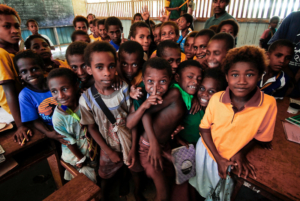Child Poverty in Papua New Guinea: Health care and Education
 Children in Papua New Guinea (PNG) represent kinship, community and unity. Yet, many of them suffer neglect. Child poverty in Papua New Guinea has left 41% of the country’s children living in difficult conditions. There is an increasing level of concern for the lack of education and health care in the country.
Children in Papua New Guinea (PNG) represent kinship, community and unity. Yet, many of them suffer neglect. Child poverty in Papua New Guinea has left 41% of the country’s children living in difficult conditions. There is an increasing level of concern for the lack of education and health care in the country.Education
Only 35% of students complete primary school due to factors such as poor teacher training, low enrollment levels as well as the long and dangerous journeys many children have to embark on to get to school. A 2010 report found that the PNG government was failing to educate around 2 million elementary and primary school-aged children. This also carries into adulthood, with an estimated half of the population unable to read or write.
Improving Education
Health Care
The lack of access to basic health care impacts child poverty in PNG. Infant mortality rates and childhood malnutrition have been the highest in that region of Asia. Statistics have revealed that nearly half of children between 6 to 59 months suffer from stunting and 16% of children under the age of 5 are too thin for their height.
Improving Health Care
PNG’s neighboring country, Australia, has played an important role in supporting the health care systems. Also, with the help of World Vision International, Australia is helping to address child health care issues in PNG through a variety of routes. One solution the country has implemented is to increase education on nutrition and encourage more healthy eating driven by locally available ingredients. Through investments in health care, around 28,628 people in PNG have been provided with access to essential medical treatments.
Looking Ahead
Despite the challenges that children in PNG face, efforts are underway to improve their education and health care conditions. Initiatives supported by Australia and organizations like World Vision International are helping to raise education levels, remove barriers to school attendance and provide better teacher training. Additionally, investments in health care are addressing child health issues, increasing access to essential medical treatments and promoting nutrition education. These endeavors offer hope for the alleviation of child poverty in Papua New Guinea.
Photo: Flickr
